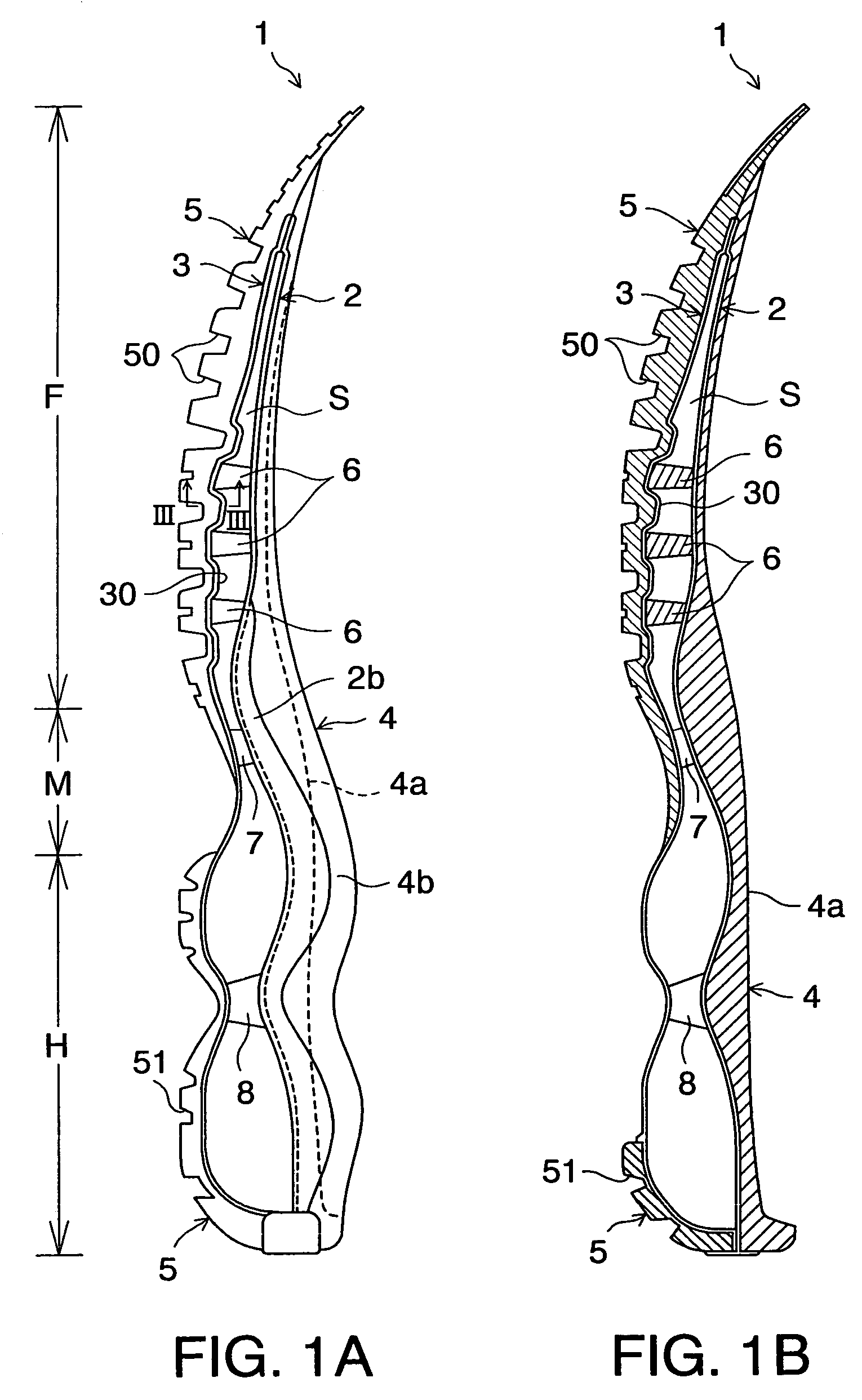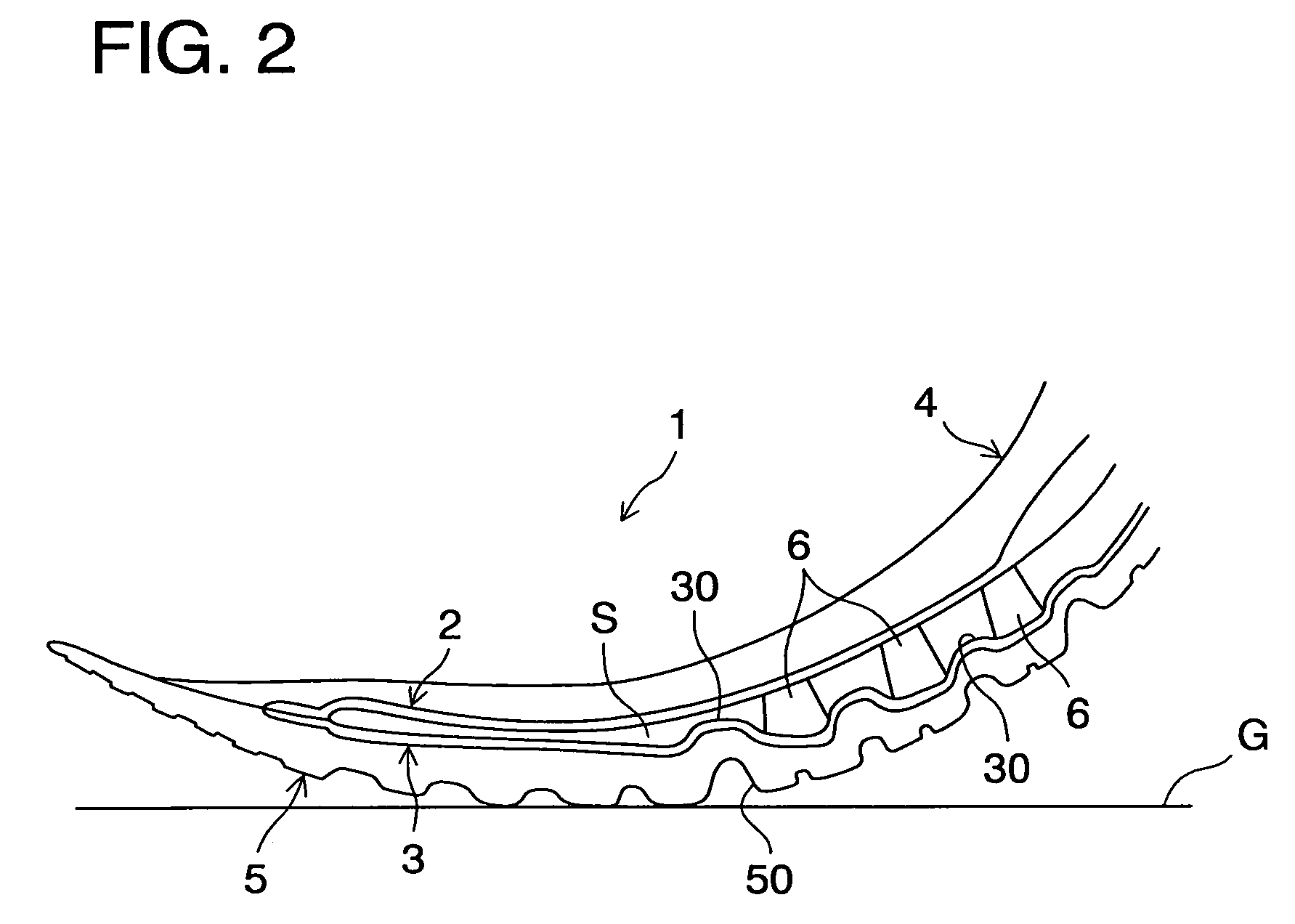Sole structure for a shoe
a technology for shoe soles and forefoot, which is applied in the direction of fastenings, footwear, apparel, etc., can solve the problems of affecting achieve the effect of improving the bendability of the sole forefoot portion, preventing further supination of the foot on the ground, and being easily and immediately introduced into the inside of the sho
- Summary
- Abstract
- Description
- Claims
- Application Information
AI Technical Summary
Benefits of technology
Problems solved by technology
Method used
Image
Examples
first embodiment
[0042]Referring now to the drawings, FIGS. 1A and 1B show a sole structure according to the present invention. The sole structure 1 for a shoe includes an upper plate 2 extending from the heel portion H through the midfoot portion M to the forefoot portion F, and a lower plate 3 disposed below the upper plate 2 and extending from the heel portion H through the midfoot portion M to the forefoot portion F. A void S is formed between the upper plate 2 and the lower plate 3. The upper and lower plate 2, 3 extend in the shoe width direction (or into the page of FIG. 1A) as well.
[0043]Above the upper plate 2 is provided a midsole 4 formed of a soft elastic material and extending from the heel portion H through the midfoot portion M to the forefoot portion F. The upper plate 2 is fixedly attached to the bottom surface of the midsole 4. The midsole 4 has a foot contact surface 4a that contacts the sole of a shoe wearer's foot and an upraised portion 4b formed at opposite side edges of the f...
second embodiment
[0072]FIGS. 5A and 5B show a sole structure according to the present invention. In these drawings, like reference numbers indicate identical or functionally similar elements.
[0073]As with the sole structure 1 of the above-mentioned first embodiment, the sole structure 1′ according to the second embodiment has the upper and lower plate 2, 3 extending from the heel portion H to the forefoot portion F and located away from each other via the void S. The sole structure 1′ differs from the sole structure 1 in that the upper plate 2 of the sole structure 1′ has a plurality of convex portions 20 protruding toward the lower plate 3 in the central region to the rear region of the forefoot portion F. These convex portions 20 protrude toward the position between the longitudinally adjacent convex portions 30 of the lower plate 3.
[0074]In the case as well where not only the lower plate 3 but also the upper plate 2 has the convex portions, similar to the first embodiment, the longitudinal path l...
third embodiment
[0079]FIG. 6 shows a lower plate of the present invention. As shown in FIG. 6, the lower plate 3 has a longitudinally extending indentation 35 formed centrally in the forefoot region.
[0080]In this case, the medial and lateral portions of the lower plate 3 disposed on opposite sides of the indentation 35 can deform downwardly independently of the other portion, thus improving the lateral bendability of the sole forefoot portion. In this case, a sole structure can be achieved that is suitable for sports such as tennis, basketball or the like where side steps are required.
[0081]The position of the indentation 35 is not limited to the laterally central position of the lower plate 3, and it may be located at the position either closer to the medial side (i.e. the great toe side) or the lateral side (i.e. the little toe side). Also, by properly adjusting the width and number of the indentation 35, the way of deformation of the medial portion and the lateral portion of the lower plate 3 ca...
PUM
| Property | Measurement | Unit |
|---|---|---|
| angle | aaaaa | aaaaa |
| bending angle | aaaaa | aaaaa |
| longitudinal path length | aaaaa | aaaaa |
Abstract
Description
Claims
Application Information
 Login to View More
Login to View More - R&D
- Intellectual Property
- Life Sciences
- Materials
- Tech Scout
- Unparalleled Data Quality
- Higher Quality Content
- 60% Fewer Hallucinations
Browse by: Latest US Patents, China's latest patents, Technical Efficacy Thesaurus, Application Domain, Technology Topic, Popular Technical Reports.
© 2025 PatSnap. All rights reserved.Legal|Privacy policy|Modern Slavery Act Transparency Statement|Sitemap|About US| Contact US: help@patsnap.com



